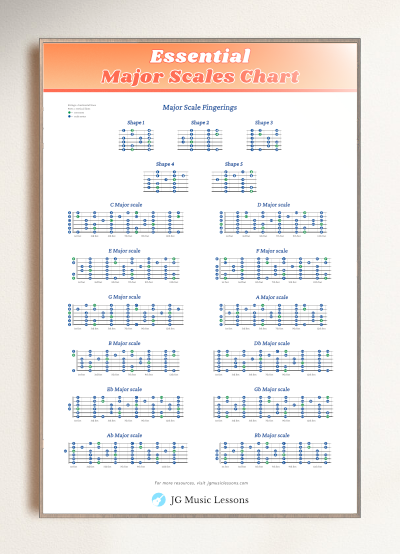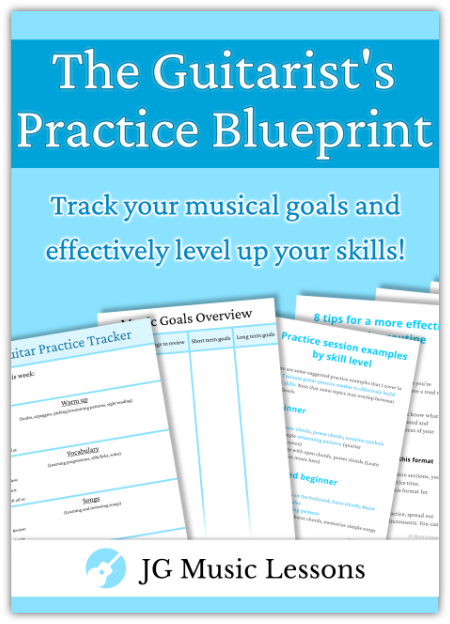Improvising on guitar is one of the most challenging but rewarding skills that takes intentional time to get better at.
Rather than thinking of music improvisation as a purely spontaneous ability, it’s actually the gradual development of smaller concepts that eventually help you to come up with musical ideas on the spot.
In this post, we’ll cover 9 tips to get better at improvising on guitar so you can take your skills to the next level! Let’s get started.
1. Being flexible with scales
In order to be able to improvise effectively, it’s essential to have a good foundation of scales and how to be flexible with them. We use scales as a map to choose the right notes over a chord or progression. If you don’t have your basic scales down, you’ll find yourself guessing the notes on the guitar.
A great place to start is learning the 5 Major scale shapes. This will give you a good basic foundation of how to move around your fretboard and connect musical ideas without getting stuck in one position.
Learn scale patterns
Once you learn the notes of a scale, it’s helpful to learn patterns to break up the order of notes. You don’t just want to play a scale up and down because it will sound like an exercise. Instead, we want to make our improvisation sound fresh and interesting for the listener.
One way of playing a scale pattern is using sequences of consecutive notes. For example, a 3 consecutive note sequence using the E minor scale would be:
E, F#, G, then,
F#, G, A, then,
G, A, B, etc…
Here is an example of this 3 note E minor scale pattern over an E minor 7 chord and a D Major chord.

You can try ascending sequences (low to high notes), descending (high to low notes) or even alternating between the two.
Here is another example of a 4 note E minor pentatonic scale pattern over the same chords as the previous example.

Using intervals within a scale
Another concept you can explore in improvisation is the use of intervals within a scale. An interval is a distance between 2 notes in a scale. Every interval has a distinct sound that you might want to use instead of playing a linear scale to improvise.
Here is an easy way to think about intervals:
Interval of a second – one note to the next in a scale (For example, C to D)
Interval of a third – skip 2 notes within a scale (C to E)
Interval of a fourth – skip 3 notes within a scale (C to F)
Interval of a fifth – skip 4 notes within a scale (C to G)
Interval of a sixth – skip 5 notes within a scale (C to A)
Interval of a 7th – skip 6 notes within a scale (C to B)
A nice way to harmonize a melody is using 3rd and 6th intervals. Here is an example of an E minor scale using descending 6th intervals.

I go in more detail on intervals in this post about how to practice scales on the guitar.
2. Explore rhythmic ideas
At the same time, we can vary the rhythms within a pattern to make it sound more melodic. For example, here is an E minor blues scale using different note lengths.

You can also try starting your phrases on different parts of the beat. Here is a similar series of notes as the previous example except we start the phrase later in the 1st measure (beat 4 in 6/8 time).

You can try playing a phrase on different parts of a beat and see which one you like best. Working out this kind of exercise during your practice time will make you more flexible with rhythm when improvising.
3. Learn and create melodies
A great way to make your improvisation sound better is to create melodies within your solo. An effective way to do this by learning a lot of melodies, solos, or phrases, also known as licks. Try to understand what makes a melody or a phrase sound and then create your own. For an example, you can expand your music vocabulary by learning these 7 jazz and blues licks over a dominant 7 chord.
The melody is usually the part that stands out the most when you listen to a song. If you think of melodies within your improvisation, they will naturally stand out to the listener rather than just playing the “right notes”.
Another helpful tip that I recommend is to try to sing a phrase that you think will sound good and try to play it on your instrument. This will help you develop your ear training to play what you hear instead of always reverting to what your fingers are used to doing.
The more time you spend creating and learning melodies, the more natural this skill will become. Your improvisation will flow more naturally and you’ll avoid sounding mechanical.

4. Soloing over related chords
Understanding how chords are related is very important when improvising on guitar because it will help you to group chords under one related scale. Instead of thinking of one scale for every chord, you can think of a key center.
Diatonic chords (related chords) chart
When several chords are related to one scale, this is referred to as diatonic chords. Using the notes within one Major scale, we can build the following chord qualities on each scale degree.
| Scale degree | Chord quality | 7th chords |
| 1 | Major | Major 7 |
| 2 | minor | minor 7 |
| 3 | minor | minor 7 |
| 4 | Major | Major 7 |
| 5 | Major | Dominant 7 |
| 6 | minor | minor 7 |
| 7 | Diminished | Half diminished |
Using this concept we can understand the connection between related chords. For example, if we were to apply this to a G Major scale, we get the following diatonic 7th chords: G Major 7, A minor 7, B minor 7, C Major 7, D 7, E minor 7, and F# half diminished. This is what these chords sound like:

Even if you change the order of the chords, you’ll see that using one parent scale works over all the chords.
See how to play half diminished chords (aka minor 7 b5 chords) here if you don’t know them already.
In this example, I’m using a G Major scale over the following the chords: E minor 7, D Major, A minor 7, and B minor 7.

Knowing how chords are related will also help you play and compose with modes to create unique sounds and emotions.
5. Create phrase sequences
Creating phrase sequences is when you play a musical idea and either repeat it or create a variation of it. This approach will help connect your ideas to create a more natural flow in your solo.
You can also use sequences to surprise the listener with a change of idea that was similar to the previous one you played.
This is can even be as simple as changing a few notes as you’ll see in the following example.

You think of a sequence as a short melody or series of notes that are repeated within a chord progression. Most popular songs use this element of repetition to help the listener remember a piece of music. Experiment with using sequences when improvising and see what works best within the musical context.
6. Know the song form
Whether it’s a chord progression of four chords, a 12 bar blues, or a 32 measure song form, you really have to learn and memorize the progression to improvise clearly and effectively. Knowing the chords and sections of a song gives you the confidence to choose the right notes and avoid fumbling through the chords.
Not only is it good to memorize the chord progression you’re soloing over but also learn the melody so that you can use it to make variations and embellishments with it.
When learning a song form, take into account how long each section lasts and if there are any key changes. In short, the better you know the song form, the easier it will be to stay on track with the right chords for your solo.
7. Transcribing
Transcribing is the act of listening and often writing down music so that you can analyze and learn it yourself. I think that transcribing is one of the most helpful things you can do to get better at improvisation because you can understand what makes a solo sound good and how you can apply it to your playing.
The process of transcribing takes intentional listening and repetition until you can play a phrase or solo. It would be ideal if you can write down those ideas in music notation so that you can analyze the notes and review them later on.
Practicing transcription to learn songs and solos that you like. You can look into genres like rock, jazz, or blues which are big on including improvisational parts within a song.
8. Outlining chords
Outlining chords means that you highlight specific notes of the chords you are playing over. Being able to outline chords creates richness and depth to your playing rather than only playing a related scale over many chords.
You can start to apply this concept with some basic understanding of triads. The three notes of a triad define the structure of a chord. For this next example, we’ll use an F Major chord which has the triad notes F, A, and C and a Bb Major chord which has the triad notes Bb, D, and F.
The following example outlines this simple chord progression: F, Bb, F, Bb.

Also, experiment with different rhythms between triad notes when outlining chords.
Start by challenging yourself to only play the triad notes in one chord but later you can mix it along with other related scale notes.
It’s a good challenge to take a chord progression or a whole song form to practice outlining chords. Although it takes time to work out the right notes over chords, you’ll soon notice the difference it makes to give depth to your improvisation.
You can also apply this concept to 7th chords. For example, see how to play Major 7 arpeggios, Dominant 7 arpeggios, or minor 7 arpeggios on guitar.
9. Telling a story
A good solo is crafted as if your telling a story with a beginning, development of ideas, a build up to a climax, and an ending.
This approach to improvisation will certainly be much more interesting to listen to rather than just playing without connecting ideas. Being able to freely express your ideas on the instrument involves learning all of the concepts we looked at previously.
For example, you could start with sparse notes and build up to faster and more complex rhythms. Or you can also start with a lower range of notes and then you end at a high range of notes for the climax of the solo.
Another thing you can do is to start with notes that fit the chord progression but gradually build up to using more dissonant notes to create good tension in your solo. Using dynamics (how loud and soft you play notes) also plays a big part in how you can express a flow of ideas to tell a story.
After playing a musical phrase, try to think about what would be the most complimentary thing to continue playing. Thinking of your solo as a whole can make your note selections more intentional and appealing for the listener to follow along.
Wrapping up
You can improve your ability to improvise on guitar by developing smaller musical concepts. It is a rewarding skill that takes time to work on but you’ll only get better as you continue to practice doing it.
To recap, the 9 tips to help you get better at improvising on guitar are:
1. Being flexible with scales
2. Exploring rhythmic ideas
3. Create melodies
4. Soloing over related chords
5. Create phrase sequences
6. Know the song form
7. Transcribing
8. Outlining chords
9. Telling a story
To learn more about scales and modes, see how to improvise on guitar.
📘 Get the free guitar practice guide here!
All the best,
JG Music Lessons
Original image by Parker Coffman on Unsplash
📙 Kickstart your guitar playing with our step by step guide: Guitar Essentials.
🎸 Looking for a travel or half-sized guitar? See this one.
🛠 See our other music recommendations.
🤝 Support the site to help us to create better content for you!
Level up with the FREE guitar practice guide and effectively improve your playing! 🎸
Get it sent to your email!



